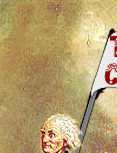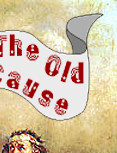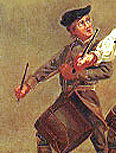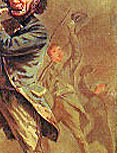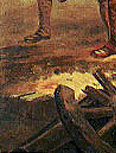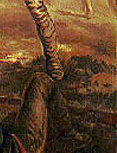|
|
|
July 27, 1999 SOCIOLOGY, INDO-EUROPEANS, AND THE DESTINY OF THE WARRIORSIn 1987-91 I must have had too much time on my hands. I actually did an informal survey of what was going on British sociology. It wasn't pretty. British sociology was "eat up" with Structural Marxism, that French imposture made up by Louis Althusser (Half-Hussar, as I call him) and his merry band. In the hands of British academic lefties, who took the whole thing too seriously, it was even worse. Standard textbooks intended for A-Level and AS-Level students went on endlessly about the two-class model of society – bourgeoisie (hiss) and proletarians (cheers, mate) – but with all those extra subclasses ("fractions" – 3/8, 5/6?) making up the layer-cake of our oppressive Western "social formations." There was, however, some light shining through the dialectical gloom. I inadvertently discovered what might be called the British Post-Marxist School of Sociology, writers who have noticed that political power exists and may not always be reducible to some elusive economic "base." Here we find Sir Ernest Gellner, no friend of the market or classical liberalism, but a cranky and witty critic of Marxist sociology both Western and (then) Soviet. Even better were Michael Mann and John A. Hall. (There are some others.) Hall began his analyses in historical sociology with the proposition that there are three forms of "power" (understood, I suppose, as the ability to get things done) in human history – ideological, political-military, and economic – none of which determines the others "in the last instance." This seemed a step forward. As happens over and again in Western thought, Hall has reinvented the Indo-European wheel, as Sir Ernest likewise did in his discussion of "plough, sword, and book." And this brings us to the late Georges Dumezil, the giant of comparative Indo-European linguistics and mythology. (I realize this may put off multiculturalists, but you can't please everyone unless you are the Democratic Party.) Dumezil – and his followers – by painstaking comparative study of the earliest literatures associated with our own language family (mythology, epic, and early Roman pseudo-history as in Titus Livy) "reconstructed" a set of ideas about the proper order of society – an ideology. This worldview traveled with the speakers of the related tongues, undergoing much modification over time and space. (This frees us from worrying about the Whorf-Sapir hypothesis in which language "determines" thought.) One emergent theme of this reconstructed world-outlook is a near-obsession with grouping everything into threes – a habit still alive in the works of Hegel and Marx and, possibly, in the American Constitution. Ideally, society consisted of three "functions" (castes): Priests, Warriors, and Economic Producers (herdsmen, farmers, craftsmen – that is, the ancestors of most of us). Celtic Ireland's druids, bo-aire, and grad fene and Vedic India's brahmans, kshatriyas, and vaisyas corresponded exactly to the Indo-European model (with the addition in India of a fourth group, the conquered sudras). In Dumezil's words, the hierarchical society in Plato's Republic is "une reminiscence indo-europeenne" and, despite Christianity, the tripartite view of society underwent a remarkable revival at the hands of 10th and 11th-century clerics, who aimed at strengthening the feudal monarchy and divided the people into "those who pray," "those who fight," and "those who work" (and see George Duby on this). There are colors, too: white for priests, red for warriors, and blue (sometimes green or black) for the farmers/herdsmen/craftsmen. (I think we have seen this scheme in several national flags.) The three-caste order remained the legal description of France down to the Revolution. In these terms, classical liberalism represents the revolt of the Third Estate against an Old Order in which the other two Orders were dominant. The political upheavals of the 17th and 18th centuries left liberals up against the question of how best to provide for the "Second Function" (warriors, national defense) without creating new dangers to liberty. Some materials lay at hand in republican theory, revived during the Renaissance (and itself reflecting classical Greek and Roman departures from the tripartite view of society). The solution to which the American Founders leaned (and which they embedded in the Constitution) drew on the English reading of republican theory and set up the armed citizens ("the militia") as the federal republic's first line of defense (genuine defense as opposed to worldwide armed philanthropy) . This was one reason for the Second Amendment (the other being an individual right to defend oneself and one's property, which drew on classical liberalism and English law). Time and again, spokesmen for the new Constitution made the point that an armed population would able to resist tyrannical encroachments (terribly unlikely, of course) by the new government. To this citizen-based system of defense, the new republic added a small standing army and a modest navy, which finally grew, like Topsy, making their bosses the World's Last Remaining Super Power, which like the ancient Athenian Empire has the "right to rule, because we overthrew the Persians." Scholars could get inside Indo-European ideology because the myths and epics dealt with whole sets of gods and heroes who "represented" the three social functions. (Here Dumezil echoed Durkheim, Marcel Mauss, and Marcel Granet.) These tales take in, among other things, sins and misdeeds likely to rise up in each caste. In the case of the Second-Function warriors, the danger is that they will use their training and talents against the people and society which it is their job to defend. As Dumezil and Jaan Puhvel show, there is a whole body of myth in which this theme unfolds. We see it with Cuchulainn, the Third Horatius, Indra, and others. Cuchulainn and Batraz had to have their martial ardor cooled with enormous quantities of water lest they destroy their own society. This last thing isn't as much of a worry for us, as far as our military functionaries go – they tend to be cold-blooded technicians these days – but perhaps their civilian-militarist bosses should take a few cold showers. Even they show rather little real ardor except during air campaigns or when an ideological bug bites them. But they, too, have a myth to live by. Their myth is Science! (blinded with?), as understood by a mob of 19th-century worthies beginning with Auguste Comte, whose key notion was that human society is as transparent and subject to manipulation as any problem in 19th-century physics. This "scientism" (as Friedrich Hayek called it in The Counter-Revolution of Science) comes down to us in two broad streams: from Comte's Positivist cadres to early 20th-century Progressives and social engineers (among whom we may include Dr. Hendrik Verwoerd, architect of Grand Apartheid), and from Comte through Marx and his followers. Revisionist Marxists, by moving towards the center, brought about a happy reunion of the two lines. These are the people who want to give us The End of History. (My suggested bumper-sticker: "Marx, Freud, and Darwin: Two Down, One To Go.") It is not without interest that by working towards a society dominated by a secularized priesthood or New Class made up of themselves and backed up with all those "weapons of mass destruction" (which would be so dangerous in other hands), our present rulers are recreating the Old Order in which the first and second "functions" (estates) command the third. Their chief innovation is to be doing so without God, or even a short-list of pagan gods, but in the name of Humanity (Feuerbach, call your office) and Science. Nil sub sole novi – there is nothing new under the sun. As Jaan Puhvel notes, President Nixon was nearly impeached for "abuse of justice, abuse of power, and abuse of money" (Puhvel quotes James Jackson Kilpatrick here) – that is, for crimes pertaining to each social "function." If mythic themes don't go away, it is because they embody important truths about persistent problems. Films like "The Siege" and "An Enemy of the State" remind us that the great issues of "tribal security" are still with us. Besides, if the present Empire and its "defensive alliance" ever have to rescue anybody in the Caucasus, the story of Batraz may come into better focus. Batraz was a neo-Scythian Good Old Boy from just those parts. It is not entirely the fault of the soldiers that the New Priesthood rewrote the military's mission statement while those of us in the Third Estate were taking the long constitutional nap we call the Cold War. It is not all their fault if they forgot the purpose of American foreign policy, which is to defend the freedoms of the American people (Taft said that, remember?). While on this conciliatory note, let us remind ourselves of a Roman tale about the Second Function (perhaps without parallel elsewhere). I refer to Cincinnatus, a landed gentleman who took up arms and led his republic to victory and then, with self-restraint and modesty, went back to farming his lands. This ideal – to which George Washington was early assimilated – reflects the merger of the second and third estates in defense of their society which is characteristic of republics. Had he lived much later, imperial publicists would have given us a Cincinnatus who conquered whole new realms for the Empire, went into politics, and died rich as Croesus on the profits of politically-rigged markets. I like the original story better. It reminds me of Robert E. Lee, who did his best, accepted defeat gracefully, and settled down to a peaceful life as President of Washington College. Well, that's one set of mythical traditions, to which some of us feel close because of our history and our language. Of course, this pagan Indo-European material has its limits. You get nothing like the Christian theory of the Just War in the Rig Veda, the Prose Edda, or in Titus Livy. One more thing – the poor Structural Marxists by breaking capitalist society down into ideological, political, and economic "levels," also reinvented the Indo-European wheel, but with the proviso that the "economic level" dominates "in the last instance." There is a little truth here, but things are hardly that self-starting. At times, the Third Estate has had to fight for its freedom against Estates very like the one the Marxists themselves have aspired to create. The Mode of Production did not hand their freedoms to them. History is littered with expanding modes of production stifled and suppressed by political authorities exercising that very "autonomy" they don't – according to some theorists – ever have. (Several Chinese dynasties come to mind.) I could go on about the deep connection between war, militarism, and non-market forms of economy, but that will be another day.
Joseph R. Stromberg has been writing for libertarian publications since 1973, including The Individualist, Reason, the Journal of Libertarian Studies, Libertarian Review, and the Agorist Quarterly, and is completing a set of essays on America's wars. He is a part-time lecturer in History at the college level. You can read his recent essay, "The Cold War," on the Ludwig von Mises Institute Website. His column, "The Old Cause," appears each Tuesday on Antiwar.com.
Please Support Antiwar.comA contribution of $20 or more gets you a copy of Justin Raimondo's Into the Bosnian Quagmire: The Case Against US Intervention in the Balkans, a 60-page booklet packed with the kind of intellectual ammunition you need to fight the lies being put out by this administration and its allies in Congress. Send contributions to Antiwar.com or
Contribute Via our Secure Server |

